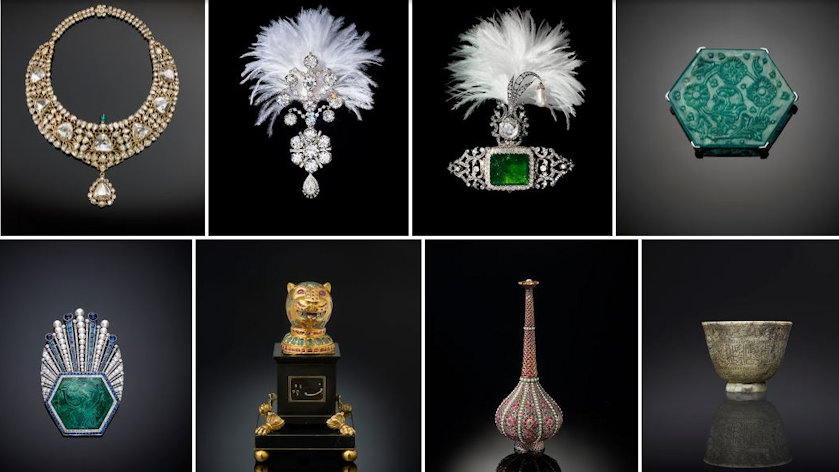The Fine Arts Museums of San Francisco (FAMSF) announce East Meets West: Jewels of the Maharajas from The Al Thani Collection, opening at the Legion of Honor on November 3. India has been renowned for its gemstones and jeweled arts for centuries, and visitors can now view more than one hundred and fifty precious objects from the collection formed by His Highness Sheikh Hamad bin Abdullah Al Thani, featuring stunning pieces from the rule of the Mughals in the seventeenth century to those reflecting the influence of India on jewelers today. Audiences are invited to observe spectacular Indian jewels and precious objects firsthand while exploring themes of influence and exchange between India and the West. Objects on display will also provide visitors with an intriguing cross-cultural look at jewelry and gender.
“This exhibition provides a riveting look at how politics and culture influence aspects of society—in this instance, jewelry,” said Melissa Buron, Director of the Art Division at the Fine Arts Museums of San Francisco. “The collection, magnificent in both its expanse and the physical size of the jewels, is an intoxicating sight to behold. We are so pleased to welcome these incredible works to the Legion of Honor.”
The Mughals, a dynasty with roots in Central Asia, ruled India from 1526 until the establishment of British control, from 1858 to 1947. Throughout this time, India was known for its exquisite production of jeweled arts and precious gemstones. Under successive Mughal emperors and the maharajas, Indian jewelry and works of art developed different styles, influenced by the disparate cultures and monarchal traditions of the time. The objects in this exhibition highlight Indian jewelry traditions including pieces worn on ceremonial occasions; weapons such as swords and daggers; and precious works of art made of gold or jade for display or use.
Unlike the European courts where women wore the most splendid jewelry, in India the male rulers, the Mughal emperors, the maharajas, nizams, and sultans, wore the most significant pieces in dazzling amounts on ceremonial occasions. The Indian male rulers wore jewelry in great profusion as necklaces, armbands, bracelets, and even anklets, signifying their high rank in society.
“The spectacular jewelry worn by the rulers of India is a captivating look into the expectations of both high culture and society across a large swath of history,” said Martin Chapman, Curator in Charge of European Decorative Arts and Sculpture. “Audiences will find this aspect of the exhibit relevant to how we perceive gender today, where equality, fluidity, and choice are important topics of conversation.”
When the Mughals arrived on the subcontinent in the sixteenth century, they brought Persian and Islamic influences to Indian jewelry. This effect can be seen in the several turban ornaments on display, which show how Persian ideas were realized in diamonds, rubies, and emeralds for the Indian rulers. India served as a principal resource for diamond trade, providing the world’s greatest diamonds. Visitors will grasp firsthand the prestige of India’s diamonds upon seeing the Idol’s Eye, a 70.2-carat diamond and the largest blue diamond in the world. Other precious objects include jade, a hardstone that Mughal rulers associated with victory, fashioned into weapons such as daggers; the material was prized, moreover, for its curative powers and was therefore carved into cups and drinking bowls. Gold was also a favored material for physical expressions of royalty, seen in Indian jewelry up to the end of the nineteenth century and in precious ceremonial vessels. The wearing of strands of pearls, which began in India as a custom for male rulers, is now found throughout the world as a fashion for women.
With the arrival of the British Raj in the nineteenth century came the influence of European styles and craftsmanship on Indian jewelry. Gold was replaced by silver and platinum for diamond-set pieces. Conversely, in the early twentieth century, India became the most prevalent influence on Western jewelry, in both its style and the use of brilliantly colored and carved gemstones. Indian jewelry inspired great European jewelry houses such as Cartier to make pieces in the Indian style, using carved and brilliantly colored gemstones. This exhibition will showcase famous gemstones such as the Arcot II diamond (formerly belonging to the British Crown Jewels), the vibrantly pink Agra diamond, and other treasures such as a jade dagger owned by Emperor Shah Jahan, the builder of the Taj Mahal.
East Meets West follows other exhibitions of jewelry and decorative arts at the Fine Arts Museums of San Francisco, including Read My Pins: The Madeline Albright Collection (2016–2017); The Art of Bulgari: La Dolce Vita and Beyond (2013–2014); and Cartier and America (2009–2010).
East Meets West: Jewels of the Maharajas from the Al Thani Collection is organized by Martin Chapman, Curator in Charge of European Decorative Arts and Sculpture at the Fine Arts Museums of San Francisco with Amin Jaffer, Senior Curator of the Al Thani Collection.




